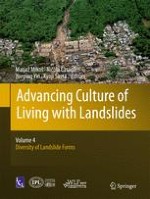Abstract
Debris flows seriously endanger the highway from Chengdu to Lhasa (G318)and often interrupt traffic in rain seasons, especially at the southeast of Tibet. A large-scale debris flow, occurred on June 23, 2012 at Haitong Watershed, blocked the Xiqu River and formed a dammed lake with the average width of 60 m, the length of 300 m and the reservoir volume of 90,000–100,000 m3. The traffic of G318 Highway was interrupted until June 30th as the result that the highway base was buried about 230 m by debris flow deposits and inundated over 160 m by dammed lake. The investigation and the analysis of debris flow deposit samples showed that the debris flow delivered about 100,000 m3 sediment out of watershed, deposited along Xiqu River and formed a dam with the length of 230 m, the width of 100 m and the average thickness of 7–8 m. The clay content and density of debris flow deposits was 0.41–0.86% and 1.89–2.01 t/m3, respectively. Using the parameters of cross sections obtained by field measuring,the velocities and peak discharge for debris flow were estimated,and the velocities of flow reached 10.9–12.1 m/s by virtue of steep channel as well as the peak discharge at the mouth, the right gully and the left gully was 924, 642 and 336 m3/s, respectively. The debris flow on June 23 formed a hazard chain which was composed of flash flood, debris flow, dammed lake and outburst flood, and the threshold of debris flow blocking river was that the discharge, the magnitude and the deposits at river channel of debris flow was 230–850 m3/s, 11,709 and 9233 m3. The active tectonic movement, abundant erosion deposits and steep geomorphology are responsible for debris flow formation, the rainstorm after long-period drought triggered debris flows and the sediments induced by channel deposits initiation at the lower of the watershed further supplied and enlarged debris flow. The highway risk were assessed using the model which was established based on dynamic mechanism, and the high-dangerous zone and middle-dangerous zone occupied 86.5%, which agreed with the actual, where were buried by debris flow deposits or submerged by the following dammed lake. Based on the hazards and risk of debris flows on June 23, the protection measures, including dangerous debris flow identification, risk assessment, rational route, integrated control and emergency plans, were recommended.
